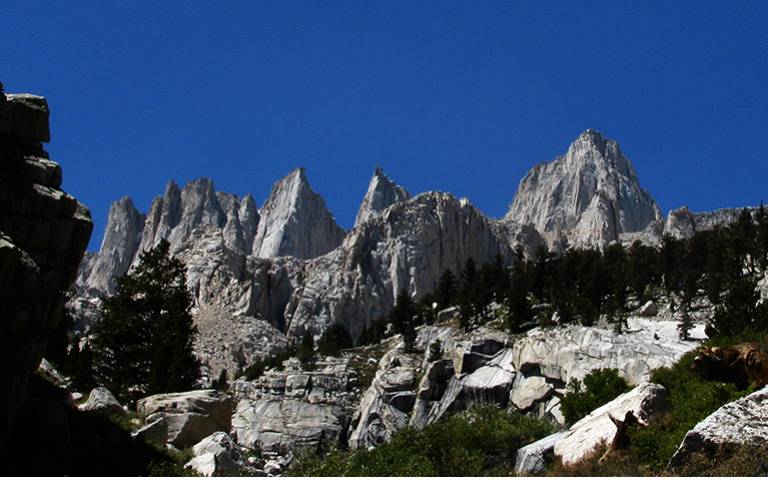PhD project: Cosmic Landscapes: disambiguating cosmogenic nuclides in detrital populations
17 May 2023
This project will focus on measuring cosmogenic 3He in rocks from the Hawai’ian islands and the Sierra Nevada (California). Laboratory work will take place in the London Geochronology Centre (UCL), SUERC (University of Glasgow), and Group 18 Labs (Arizona State University, USA).

Image: The Sierra Nevada mountain range in the Western United States.
Supervisors: Dr Byron Adams (UCL, Department of Earth Sciences), Dr Matt Fox (UCL, Department of Earth Sciences), Prof Fin Stuart (Glasgow University, SUERC)
Contact: Byron Adams (byron.adams@ucl.ac.uk)
Deadline for application: 18th June 2023 (including references)
How to apply: Application through UCL graduate school portal
Start date: No later than the 1st October 2023
The most common way to estimate the erosion rate at the landscape scale is to calculate the mean residence time of sediment in a river basin by measuring the accumulation of cosmogenic nuclides (rare isotopes formed in the near surface due to the bombardment of cosmic radiation) within the modern river sediment. The low production rate of the commonly-used nuclides (10Be and 26Al) in minerals means analysis of single grains is beyond the detection limit of mass spectrometers. Studies usually amalgamate thousands of mineral grains to yield a measurable signal and constrain a “basin-averaged erosion rate.” However, this amalgamation process means we cannot determine the distribution of nuclide concentrations within a river, diminishing the information contained within the sample and making it impossible to discern whether assumptions are violated during the calculation of erosion rates. This project will work to develop new techniques in sample preparation and analysis to explore the information contained with detrital cosmogenic nuclide concentration populations.
The laboratory results will be combined with landscape evolution models to better predict how forcing factors such as climate, tectonics, or anthropogenic activity affect erosion rates within changing landscapes. The comparison of model outputs and observations will also provide useful constraints on when it may or may not be appropriate to use basin-averaged techniques.
This project is fully funded for 4 years via The Royal Society and the UCL Department of Earth Sciences, and includes an annual tax-free stipend at the normal RCUK rate (£20,198 in 2022/23).
- Further reading:
- Bierman, P., Steig, E.J., 1996. Estimating rates of denudation using cosmogenic isotope abundances in sediment. Earth Surface Processes and Landforms, 21, 125–139. 3.0.co;2-8 ">https://doi.org/10.1002/(sici)1096-9837(199602)21:2<125::aid-esp511>3.0.co;2-8
- Codilean, A.T., Bishop, P., Stuart, F.M., Hoey, T.B., Fabel, D., Freeman, S.P.H.T., 2008. Single-grain cosmogenic 21Ne concentrations in fluvial sediments reveal spatially variable erosion rates. Geology, 36, 159. https://doi.org/10.1130/G24360A.1
- Fox, M., Leith, K., Bodin, T., Balco, G., & Shuster, D. L., 2015. Rate of fluvial incision in the Central Alps constrained through joint inversion of detrital 10Be and thermochronometric data. Earth and Planetary Science Letters, 411, 27-36. https://doi.org/10.1016/j.epsl.2014.11.038
- Gayer, E., Mukhopadhyay, S., Meade, B.J., 2008. Spatial variability of erosion rates inferred from the frequency distribution of cosmogenic 3He in olivines from Hawaiian river sediments. Earth and Planetary Science Letters, 266, 303–315. https://doi.org/10.1016/j.epsl.2007.11.019
- Granger, D.E., Kirchner, J.W., Finkel, R., 1996. Spatially averaged long-term erosion rates measured from in situ-produced cosmogenic nuclides in alluvial sediment. Journal of Geology, 104, 249–257. https://doi.org/10.1086/629823
- Sinclair, H.D., Stuart, F.M., Mudd, S., McCann, L., Tao, Z. (2019) Sediment routing from Miocene to present in the Great Plains determined using detrital cosmogenic 21Ne. Geology 47, 3-6. https://doi.org/10.1130/G45391.1
This project would suit a quantitative scientist with at least a 4-yr degree in geoscience, engineering, or chemistry and a strong interest in geochemistry, mass spectrometry, and landscape evolution who is keen to develop laboratory skills and integrate them with fieldwork and numerical modelling. Although not a prerequisite, experience with programming and statistical languages, Matlab, Python, or C, is desirable. The student will be required to carry out fieldwork in rugged and often remote terranes so independence, physical fitness and an ability to drive will be important.
 Close
Close

